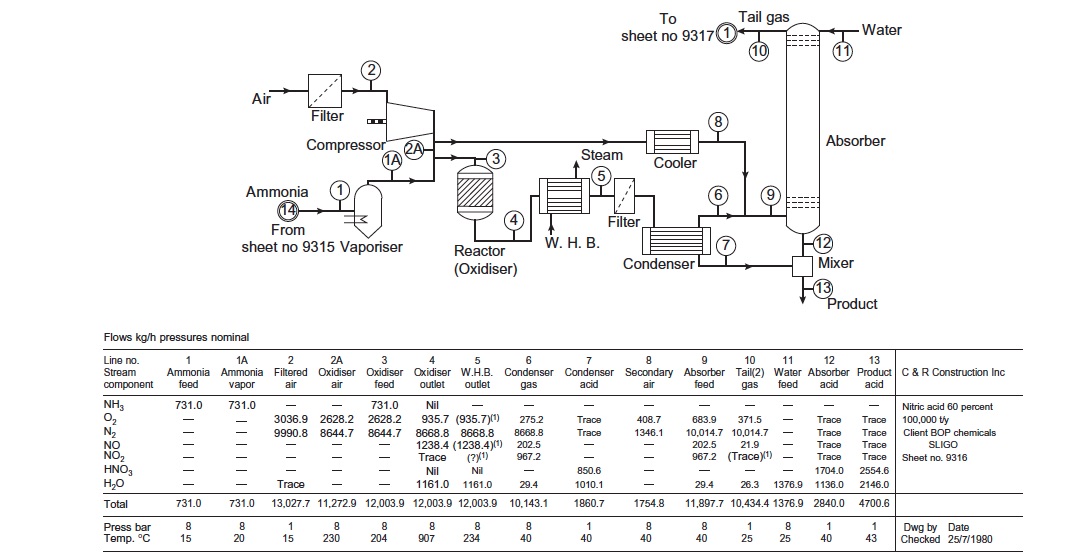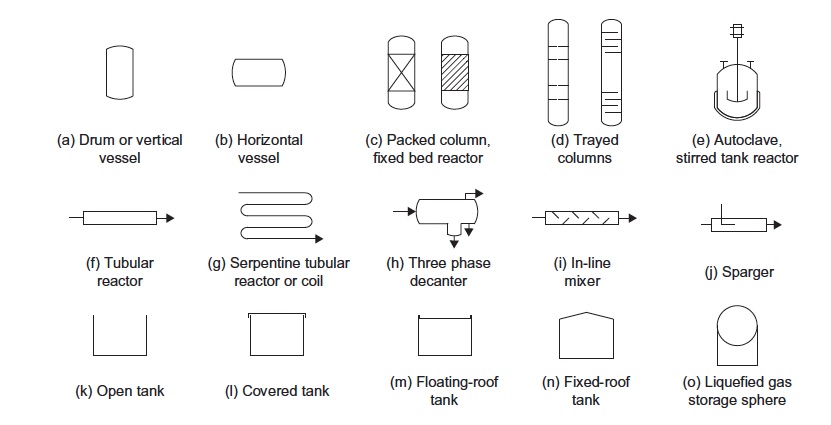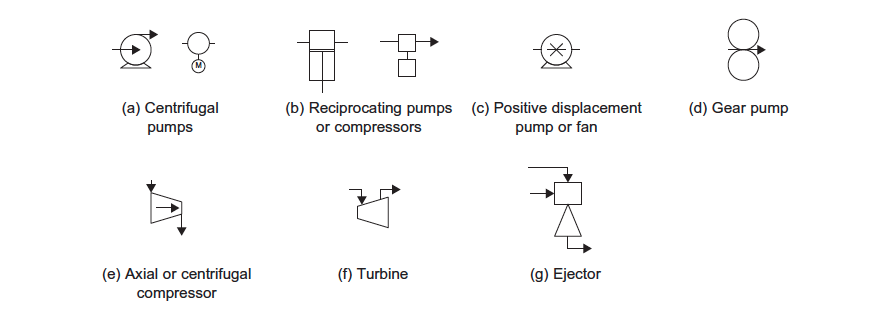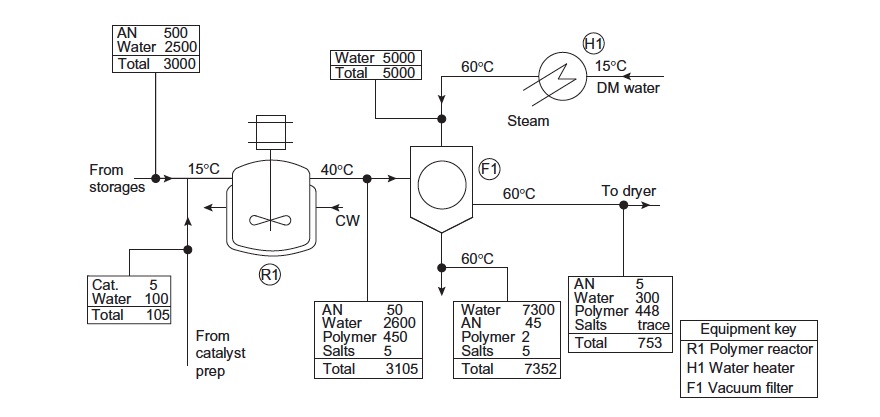Process flow diagram: Difference between revisions
| Line 57: | Line 57: | ||
===Symbols for Heat Exchanger Equipment=== | ===Symbols for Heat Exchanger Equipment=== | ||
In addition to the process equipment symbols, there will be heat exchanger equipment that are essential to process flow diagrams. | In addition to the process equipment symbols, there will be heat exchanger equipment that are essential to process flow diagrams. Notable symbols that are relevant to this class include the basic heat exchanger symbols, the shell and tube exchangers, the kettle reboiler, the U-tube exchanger, and heating coils. Other heat exchanger equipment are listed in Figure 2: (Source Towler and Sinnott, Chapter 2, page 36) | ||
[[File:PFD3.png]] | [[File:PFD3.png]] | ||
Figure 2: Various symbols for heat exchanger equipment | |||
===Symbols for Fluid Handling Equipment=== | ===Symbols for Fluid Handling Equipment=== | ||
Revision as of 18:55, 1 March 2015
Author: Tammy Wong [2015]
Stewards: Jian Gong and Fengqi You
Introduction
The process flow diagram (PFD) is a critical component of process design. It is absolutely necessary that chemical engineers know how to read process flow diagrams because it is the primary method of detailing the process and design information. Additionally, the most effective way of relaying information about a process design is the use of process flow diagrams. The PFD shows the sequence of flow through a system through the various equipment (such as piping, instrumentation, and equipment design) and details the stream connections, stream flow rates and compositions and operating conditions through the plant layout. The PFD differs from a block flow diagram (BFD) in that the PFD is more detailed and conveys more information than the BFD, which only gives a general sense of flow of information.
Overview
On the process flow diagram, there are several pieces of information that must be included while there are some optional information that can be included to make the PFD more specific. Notable information that should be included should be major process equipment and followed by a short description. Additionally, each piece of equipment should be named and listed on a table along with a description of the name. For more details on how to name process equipment, see "Naming Equipment". On the process flow diagram, all streams should be labeled and identified with a number. A summary of the streams and their numbers should also be detailed on a separate table. All utility streams that supply energy to major equipment should be shown. In Table 1, other types of essential information to the process flow diagram as well as the optional information that could be supplied to further detail the process are listed.
| Essential Information |
|
|---|---|
| Optional Information |
|
Categorization of Information In a Process Flow Diagram
The information that a process flow diagram conveys can be categorized into one of the following three groups. Each of the three aspects will be discussed in more details.
Process Topology
Process topology is defined as the interactions and locations of the different equipment and streams. It includes all of the connections between the equipment and how one stream is changed to another after it flows through a piece of equipment. On a separate table, following the process flow diagram, the equipment must be labeled (see "Naming Equipment") and followed by a short description so that the engineer who is trying to understand the process flow will have a easier time following. The following sections will describe how to catalog the necessary information for the equipment of the process topology.
Process Vessels and Equipment
One of the initial steps to creating a process flow diagram is to add all of the equipment that is in the plant. Not only is the major equipment, such as distillation columns, reactors, and tanks, necessary to be shown in a PFD, so is the equipment such as the heat exchangers, the pumps, reactors, mixers, etc). The following figures will display the most common symbols found in process flow diagrams.
Symbols for Process Technology
For process equipment, there are a few standard symbols that should be recognized by chemical engineers Typically, these symbols correlate to the ones on the Microsoft Visio Engineering package that can be used to create process flow diagrams. In the next few sections, the figures will display various symbols that are used for the process flow diagrams. Figure 1 displays typical process equipment - notables ones that should be recognized because they are relevant to this class are the symbols for the vertical and horizontal vessel, the packed column and the trayed column. (Source Towler and Sinnott, Chapter 2, page 36)
Figure 1: Various symbols for reactors, vessels and tanks
Symbols for Heat Exchanger Equipment
In addition to the process equipment symbols, there will be heat exchanger equipment that are essential to process flow diagrams. Notable symbols that are relevant to this class include the basic heat exchanger symbols, the shell and tube exchangers, the kettle reboiler, the U-tube exchanger, and heating coils. Other heat exchanger equipment are listed in Figure 2: (Source Towler and Sinnott, Chapter 2, page 36)
Figure 2: Various symbols for heat exchanger equipment
Symbols for Fluid Handling Equipment
Naming Equipment
Typical names for the equipment include a letter followed by a set of numbers. The letter usually corresponds to the first letter of the equipment. For example, the first pump in the PFD is typically labeled P-101. The following table displays the convention of naming the letters for process equipment:
- C-Compressor or Turbine
- E-Heat Exchanger
- H-Fired Heater
- P-Pump
- R-Reactor
- T-Tower
- TK-Storage Tank
- V-Vessel
- Y means that it is a specific area in the plant
- A/B identifies parallel units or backup units not shown on a PFD
Additionally, it should be noted that in a plant, certain equipment will need to be replaced. Typically, the new equipment will take the old equipment's name but an additional letter or number will be added onto the new equipment to indicate that there was a modification.
Utility Streams in Process Topology
Utilities are necessary for the plant to keep running. The purpose of the utilities is usually to add or remove heat to the equipment so that the temperature can be controlled. There are many different types of utilities that can service a plant:
- Electricity
- Compressed Air
- Cooling Water
- Refridgerated Water
- Steam
- Condensate Return
- Inert Gas
- Flares
Stream Information
In small PFDs, stream information, including flow rates, temperatures, pressures, and compositions, are shown directly next to the PFD on a table. The corresponding number on the stream will be translated onto the table. The table is usually divided into two sections - one section for the essential information and one for the optional information.
Equipment Information
In addition to the stream information, there should also be a table detailing equipment information. This table can be helpful for the economical analysis of the plant. The equipment information table should include a list of all of the equipment that is used in that particular flow diagram along with a description of size, height, number of trays, pressure, temperature, materials of construction, heat duty, area and other critical information.
Process Flow Diagram Example
Example 1: Polymer Production
In the following figure about polymer production (taken from Towler and Sinnott, Chapter 2, page 38), the PFD contains a few pieces of equipment so that the corresponding streams can be placed on the figure itself instead of on a separate table. Please note that all streams are labeled with the temperature, the flow rate and amount of each composition, and on a separate table, all of the equipment is clearly defined with their names. One improvement that can be made to this PFD is to be more detailed in the separate table and to include a description of the equipment.
However, not all process flow diagrams are as simple as the previous example. In fact, many are complicated processes that may span multiple pages. Therefore, a better example would be the following one.
Example 2: Simplified Nitric Acid Process
In the following figure, air enters a filter while ammonia enters a vaporiser to eventually combine in a reactor and form nitric acid. Each stream is labeled with a number and the compositions of the streams are labeled in a separate table. Additionally, in the separate table that follows directly below the PFD (standard convention), the pressures and temperatures of the streams are also listed. The one improvement on this PFD that can be made is to name the equipment and define those names on a separate table instead of writing the name of the equipment on the PFD. This way, there is less clutter on the PFD and it may be easier to follow along when all the names of the equipment are placed on the same table. (Source of PFD: Towler and Sinnott, Chapter 2, Page 39)

Sources
- Towler, G.P. and Sinnot, R. (2012). Chemical Engineering Design: Principles, Practice and Economics of Plant and Process Design. Elsevier.
- Seider, W.D., Seader, J.D., and Lewin, D.R. (2004). Process Design Principles: Synthesis, Analysis, and Evaluation. New York Wiley.



